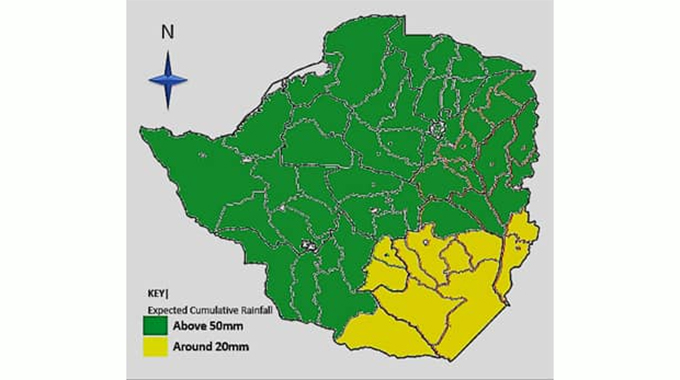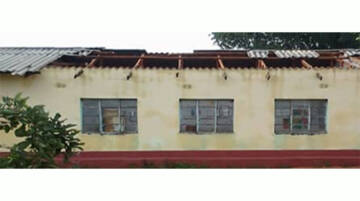More rain forecast for most parts of Zimbabwe this week

Sifelani Tsiko Agric, Environment & Innovations Editor
The Meteorological Services Department (MSD) says the country will continue to receive more rainfall this week, brightening prospects for a good harvest this season.
MSD agro-meteorologist in charge of season forecasting Mr Benjamin Kwenda told The Herald on Thursday that much of the country will receive the Inter-Tropical Convergence Zone induced rains in a forecast running from January 31 to February 6.
“Much of the country is expected to receive considerable rainfall this week (above 50mm), though the bulk of Masvingo Province, southern areas of Manicaland (Chipinge as well as Chimanimani District) and western parts of Matabeleland South have a higher probability of receiving around 20mm,” he said.
“These rainfalls are mainly influenced by the anticipated return of the ITCZ in the northern provinces covering Matabeleland North, northern parts of the Midlands, Harare Metropolitan, northern areas of Manicaland and all Mashonaland Provinces.
“This will be coupled with westerly cloud-bands that are expected to encroach into Matabeleland South and Matabeleland North from Botswana. As can be noted, Matabeleland North is being affected by both systems, thus considerable rainfall amounts are probable.”
In the south – eastern part of the country, cool south-easterly airflow should result in mostly cloudy, windy and mild conditions.
“This may be accompanied by light rain and drizzle from time to time. An odd thunderstorm remains feasible given the atmosphere gets rapidly warmed up when the clouds clear for an even short period,” Mr Kwenda said.
The bulk of rainfall in Zimbabwe and most parts of southern Africa is strongly influenced by the seasonal shifts of the ITCZ coupled with rare and episodic occurrences of cyclone-induced rains.
The ITCZ changes position during the year, moving between the Equator and the Tropics of Cancer and Capricorn. Southern Africa normally receives the bulk of its annual rainfall from November through March as the ITCZ moves south.
In a normal southern African rainy season, the ITCZ influence covers central Tanzania to southern Zimbabwe and is associated with favourable rainfall.
At this time of year, weather experts say the north-easterly monsoon of East Africa moves into the region forming a boundary with the easterly winds moving in from the Indian Ocean along the Intertropical Convergence Zone (ITCZ). Zimbabwe, Mozambique and Madagascar experience most of their seasonal rain from this system.
Heavy rains this season have caused floods resulting in the loss of crops, livestock, destruction of property – homes, schools, clinics and other key infrastructure in the country.
Last week, heavy rains and winds destroyed roofing sheets at Barura Primary School in Buhera and at Silverstone Primary School in Muzarambani.

Damaged roof at Silverstone Primary School in Muzarabani
Property, books, computer labs and other furniture were reportedly destroyed.
However, there were no reports of death or injuries.
“A case in point in the recent Muzarabani incident shows that one building with a curved roof weathered the storm and remained intact,” said Kwenda.
“This aero-dynamic design becomes a learning point on how the nation can climate-proof key infrastructure as Zimbabwe aims to build back better and build better first.”
The Met Department predicted good rains, during the 2022 – 2023 season, but farmers are now despondent as excessively wet conditions for nearly a month had led to leaching of crops.
Farmers have been urged to work closely with agricultural extension workers in their areas to devise strategies for managing leaching due to the heavy rainfall that has pounded various parts of the country resulting in the loss of valuable fertiliser applications.
Zimbabwe continues to receive normal-to-above-normal rainfall in all the 10 provinces as forecast by the Meteorological Services Department and the Southern African Regional Climate Outlook Forum (SARCOF) last year.
The 2022-2023 forecast by regional climate experts showed that there was greater potential for normal to above normal rainfall for the bulk of the region, ushering in an opportunity for good agricultural performance.











Comments